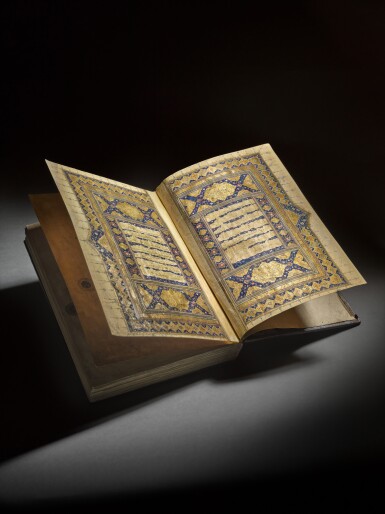
An illuminated Qur'an, Persia, Safavid, 16th century
Estimate
40,000 - 60,000 GBP
Lot Details
Description
Arabic manuscript on paper, 258 leaves, plus 2 flyleaves, 15 lines to the page written in naskh in black ink, verses separated by gold roundels with red and blue dots, within gold and polychrome rules, surah headings in gold on polychrome illuminated panels, 'ashr marked by gold and polychrome illuminated marginal roundels, f.1b and 2a with illuminated frontispiece framing text in gold, f.257b and 258a with gold and polychrome illuminated frame around text, in Safavid gilt and stamped brown leather binding, découpé doublures
text panel: 23.2 by 15cm.
leaf: 33 by 20.6cm.
inscriptions
Seal impression of ‘Wali al-Din (Veliyuddin) Efendi son of the deceased al-Hajj Mustafa Agha son of the deceased al-Hajj Husayn Agha, the year 1175 (1761-62 AD)’
This Qur’an bears the seal impression of Ottoman scholar and calligrapher Veliyuddin Efendi (1684-1768). Velyuddin held successive positions as qadi of Aleppo, Galata, Cairo and Medina. By 1756, he had been appointed kazasker (chief judge) of Anatolia, before holding the same position in Rumelia in 1758. A petition later that year led to his dismissal and exile to Manisa but Velyuddin was soon pardoned at the request of Grand Vizier Ragib Pasha, and he was allowed to return to Istanbul, where he served two terms as Sheikh al-Islam. Velyuddin Efendi was a pupil of Durmuszade Ahmed Efendi and went on to master Ottoman taliq to such an extent that he became the calligraphy tutor to Sultan Mustafa III and Sultan Ahmed III. Renowned calligrapher Mehmed Esad Yesari is said to have applied to study under Veliyuddin, though his application was rejected and Veliyuddin later expressed his regret over this. Works by Veliyuddin Efendi are preserved in calligraphic albums (muraqqa’) in the Museum of Turkish and Islamic Art, Istanbul (inv. no. 2044), the Topkapi Palace Museum Library (Güzel Yazılar, inv. no. 220), and the Istanbul University Library (FY, inv. nos. 1225, 1425, 1428), see Ozcan 2013.
The luxurious use of gold in the text of the frontispiece of this Qur’an can be related to manuscript production of the Herat school; see a Qur’an written entirely in gold sold in these rooms, 27 October 2021, lot 109. The notable use of black in the illumination framing the end of the text and the roundel verse markers are also indicative of an illuminator familiar with this style.
You May Also Like

![An extremely rare illustrated manuscript of the Ka'banameh (A history of the Ka'ba) by Abdulrahman Gubari (d.1566), signed by Ahmad [...] al-Khatib, Kaposvár, Hungary, dated Dhu'l-Hijjah 1080 AH/April-May 1670 AD](https://dam.sothebys.com/dam/image/lot/1e33ac28-a449-4673-a23f-f1ca4d5a13b3/primary/extra_small)








